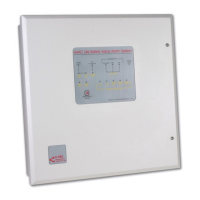A
VAC VOICE ALARM SYSTEM
AVAC Installation and Maintenance Manual • Approved Document No. DAU0000402 Rev 6 • Page 28
Supply Present light not lit
If the ‘Supply Present’ light is not lit one of the following faults has occurred:
(1) Both the mains supply and the standby batteries have failed. This could be because the
mains supply has failed and the batteries have been exhausted.
Suggested action: Restore the mains supply and the ‘Supply Present’ light should come back
on. However, if the batteries are discharged this will be recognised as a fault and indicated as
such. See “Battery voltage too low” above.
(2) The Power Supply PCB, the Main PCB and/or the cable that connects them is faulty.
If the mains supply is present (indicated by the red hazardous voltages light being lit on the
Power Supply PCB), check that the connector cable between the Power Supply PCB and the
Main Control PCB is fully inserted at both ends. If so, either the Power Supply PCB and/or the
Main Control PCB and/or the connector cable are faulty and should be replaced.
1.2 System Faults
System faults are unique in that they do not automatically clear when rectified.
Suggested action: Press the Reset button on the indicator PCB (located inside the panel).
This should clear the fault. If the fault persists, the Main PCB is faulty and must be replaced.
1.3 Amplifier/loudspeaker faults:-
The AVAC shows a loudspeaker/amplifier fault after calibration or
Adding or r
emoving an End of Line Device (EOLD) is not detected.
Suggested action:- Before starting these tests please ensure that you have a record of the
number, type, location and tapping of each loudspeaker on each circuit. The form on page
29 can be photocopied and used for this
Check whether the fault is with the AVAC, EOLD(s) or in the wiring
Remove the loudspeaker wiring and connect the EOLD(s) at the AVAC. Press and hold calibrate
until the light flashes quickly.
If the fault does not clear, check whether the fault is with the EOLDs or the AVAC by swap-
ping the EOLDs and recalibrating.
If it is an EOLD or the AVAC, contact your supplier for assistance.
If the fault lies with the external wiring there may be several causes.
First refit the EOLDs at the end of line
(1) The Loudspeaker circuit may be overloaded
The absolute maximum loading for each amplifier module is 60 watts (not less than167 ohms)
at 1 KHz. If this is exceeded, the amplifier will shut down as announcements are made or
audio is played. As the signal varies in loudness, the amplifier may operate inter
mittently
.
The most common installation error is to leave loudspeakers tapped as supplied, which is
normally the maximum load setting.
For example, a typical office environment may require 6 W ceiling loudspeakers to be tapped at
1.5 W each. A maximum of 40 x 1.5 W loudspeakers can be connected to one 60 W amplifier cir-
cuit (although we recommend you allow 20% spare capacity on each loudspeaker circuit). If the
speakers are tapped at 6 W, the load will be 240 W and the amplifier will shut down and may fail.
T
o identify this pr
oblem, use an impedance meter to measure the line impedance; which
should be no less than 167 ohms at 1 kHz or use an audio load meter to measur
e the load
dir
ectly; it must not be mor
e than 60 watts. See page 15 to calculate power fr
om impedance.
If it is more than 60 watts (less than 167 ohms), the load must be reduced by removing loud-
speakers or lowering the tappings of some loudspeakers.
(2) If the fault is intermittent or the loudspeakers cut out intermittently, one or more input
sources may be set too high.
If this problem only occurs rarely, it is likely to be related to an audio source that is seldom used.
T
r
y each of the sour
ces in turn to see if the problem occurs.
Unplug all input sources. Press the reset button. If the fault clears, this indicates that one of
the inputs is overdriving the unit.
Re-attach the inputs one at a time and set the audio working. If the fault recurs, lower the
level on that input
The remaining faults can be difficult to find so at this point it is best to check which loud-
speakers are working and whether you think they are tapped correctly.
continues >>>
Connect a pink noise (hiss) generator such as a PNGN
acr
oss the audio + and – pins of the
www.acornfiresecurity.com
www.acornfiresecurity.com

